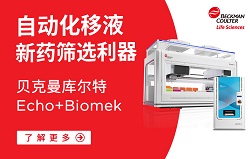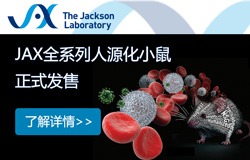Advantages of diisobutylene-maleic acid in protein purification
Description
With diisobutylene-maleic acid (DIBMA) you can directly extract membrane proteins from cells without an intermediate step of detergent solubilization, like with SDS that would usually interfere with the proteins function. Another advantage of DIBMA as a tool for protein solubilization is the lack of an absorbance maxima at 280 nm in comparison to SMAs, as their aromatic amino acids would usually absorb at the same spectrum and therefore interfere with protein quantification. PureCube DIBMA is lyophilized from two different buffer solutions (HEPES or TRIS) to ensure a stable pH of 7.5, which is ideal for most protein solubilizations. A good publication to read up even more details about DIBMA is Oluwole et al. 2017.
One challenge when working with traditional DIBMA is its sensitivity to the presence of ions inside the buffer / media. The reason for this is DIBMAs own charge that lets it interact with these ions. This leads to precipitation of DIBMA and therefore loss of its function. To overcome this issue we modified DIBMA to have a reduced charge to drastically reduce the affinity to the ions. This was achieved by adding Glucosamine or an amino-functionalized diol to DIBMA. This modified DIBMA can be used for experiments for which the presence of ions is crucial for their success.
Datasheets
Citations
Lab Results
For the longest time, the science behind membrane proteins relied on detergents for both solubilization and stabilization. However, detergents such as DDM or LMNG come with their set of problems. A time-consuming screening process for the correct detergent and the constant need to add it to all buffers can be avoided. But this applies to all synthetic nanodiscs.
Figure 1 shows the amount of membrane protein of interest that was stabilized by a DIBMALP in comparison to a construct using the detergent DDM. As it can clearly be seen DDM has way fewer specific bands at the desired kDA values of around 40-60 kDa.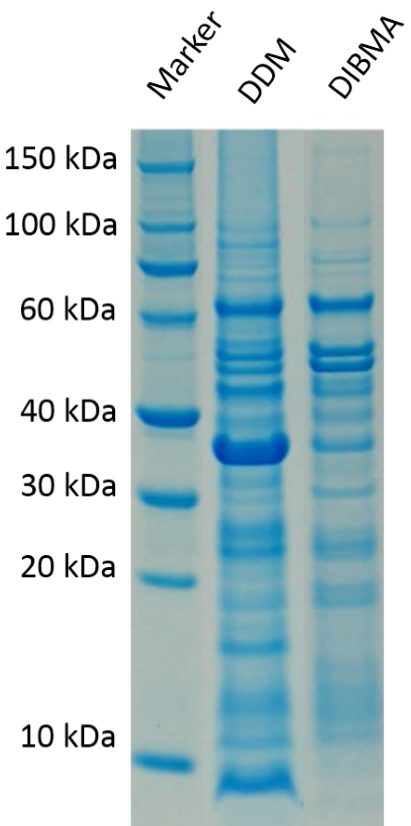
An alternative to traditional DIBMAs and their sensitivity to the presence of ions inside a buffer, are our modified DIBMAs with added Glucosamine or amino-functionalized diol. As figure 2 indicates, the increased tolerance of Ca2+ is necessary. Normally DIBMA starts to precipitate in Ca2+ holding buffers at concentrations of around 25 mM. Using DIBMA-Glycerol this tolerance increases to 50 mM. There is no precipitate visible at the bottom of the tube. In comparison, normal DIBMA shows a visible precipitate at 25 mM. In terms of Mg2+ tolerance traditional DIBMA and the Glycerol-DIBMA both show a high tolerance above 50 mM.
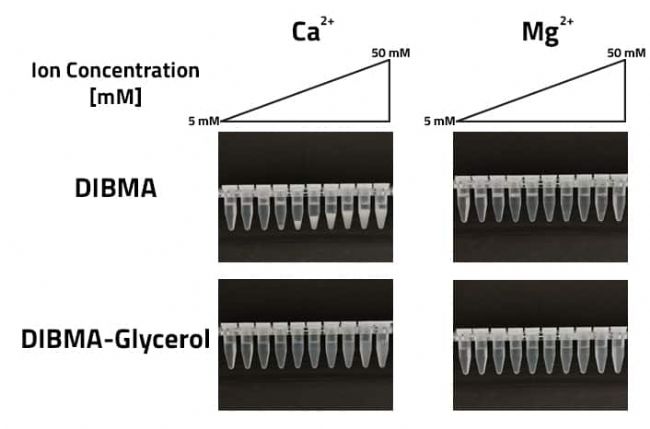 Fig. 2: DIBMA precipitation in relation to the ion concentration. The shown concentrations start at 5 mM and are increasing in 5 mM steps up to 50 mM.
Fig. 2: DIBMA precipitation in relation to the ion concentration. The shown concentrations start at 5 mM and are increasing in 5 mM steps up to 50 mM.
With diisobutylene-maleic acid (DIBMA) you can directly extract membrane proteins from cells without an intermediate step of detergent solubilization, like with SDS that would usually interfere with the proteins function. Another advantage of DIBMA as a tool for protein solubilization is the lack of an absorbance maxima at 280 nm in comparison to SMAs, as their aromatic amino acids would usually absorb at the same spectrum and therefore interfere with protein quantification. PureCube DIBMA is lyophilized from two different buffer solutions (HEPES or TRIS) to ensure a stable pH of 7.5, which is ideal for most protein solubilizations. A good publication to read up even more details about DIBMA is Oluwole et al. 2017.
One challenge when working with traditional DIBMA is its sensitivity to the presence of ions inside the buffer / media. The reason for this is DIBMAs own charge that lets it interact with these ions. This leads to precipitation of DIBMA and therefore loss of its function. To overcome this issue we modified DIBMA to have a reduced charge to drastically reduce the affinity to the ions. This was achieved by adding Glucosamine or an amino-functionalized diol to DIBMA. This modified DIBMA can be used for experiments for which the presence of ions is crucial for their success.
Datasheets
| FEATURES | |
| Usage | Protein solubilization |
| Formula Weight | ~10,000 or 12,000 g/mol |
| pH | 7.5 in buffer |
| dn/dc | 1.35 M-1 |
| Solubility | > 10 % in H2O |
| Absorbance at 280 nm | < 0.3 (1 % solution) |
| Mg2+ Tolerance | Dependend on DIBMA product Increased with less charged DIBMAs |
| Ca2+ Tolerance | Dependend on DIBMA product Increased with less charged DIBMAs |
| Shipping Temperature | ambient temperature |
| Storage of lyophilized copolymer | -20°C for several years |
| Storage of dissolved copolymer | 2-8°C for several days |
| Structure | 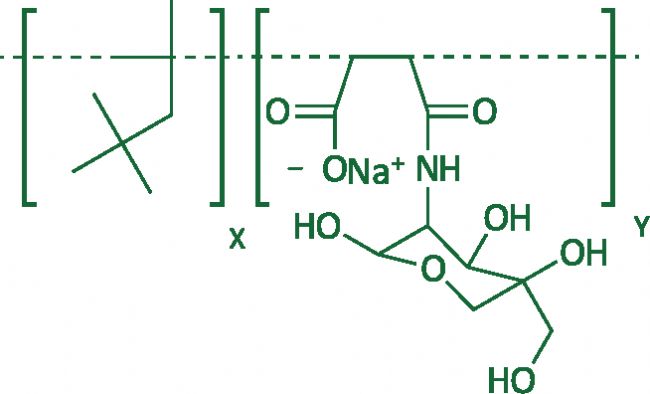 |
| STABILIZED PROTEIN | YEAR | AUTHOR |
| - | 2021 | Brown C.J. , Trieber C., Overdiun M.13 |
| ATP-binding cassette (ABC) transporter | 2023 | Dimitrova V.A., Song S., Karagiaridi A., Marand A., Pinkett H.W. |
| Env-protein of HIV | 2023 | Zhou R., Zhang S., Nguyen H.T., Ding H., Gaffney A., Kappes J.C., Smith III. A.B.S, Sodroski J.G. |
Lab Results
For the longest time, the science behind membrane proteins relied on detergents for both solubilization and stabilization. However, detergents such as DDM or LMNG come with their set of problems. A time-consuming screening process for the correct detergent and the constant need to add it to all buffers can be avoided. But this applies to all synthetic nanodiscs.
Figure 1 shows the amount of membrane protein of interest that was stabilized by a DIBMALP in comparison to a construct using the detergent DDM. As it can clearly be seen DDM has way fewer specific bands at the desired kDA values of around 40-60 kDa.

Fig. 1: The yield of DIBMA-based nanodiscs compared to detergent micelles (e.g. DDM detergent)
An alternative to traditional DIBMAs and their sensitivity to the presence of ions inside a buffer, are our modified DIBMAs with added Glucosamine or amino-functionalized diol. As figure 2 indicates, the increased tolerance of Ca2+ is necessary. Normally DIBMA starts to precipitate in Ca2+ holding buffers at concentrations of around 25 mM. Using DIBMA-Glycerol this tolerance increases to 50 mM. There is no precipitate visible at the bottom of the tube. In comparison, normal DIBMA shows a visible precipitate at 25 mM. In terms of Mg2+ tolerance traditional DIBMA and the Glycerol-DIBMA both show a high tolerance above 50 mM.
 Fig. 2: DIBMA precipitation in relation to the ion concentration. The shown concentrations start at 5 mM and are increasing in 5 mM steps up to 50 mM.
Fig. 2: DIBMA precipitation in relation to the ion concentration. The shown concentrations start at 5 mM and are increasing in 5 mM steps up to 50 mM.
標(biāo)簽:
蛋白純化;膜蛋白;DIBMA
- IPHASE亮相第十四屆藥理學(xué)會(huì)藥物和化學(xué)異物代謝會(huì)議
- IPHASE亮相第十四屆藥物和化學(xué)異物代謝學(xué)術(shù)會(huì)議
- IPHASE助力區(qū)域創(chuàng)新發(fā)展活動(dòng)暨產(chǎn)學(xué)研聯(lián)動(dòng)創(chuàng)新交流會(huì)
- IPHASE課堂第三期:轉(zhuǎn)運(yùn)體研究原理及設(shè)計(jì)
- 北京華創(chuàng)恒達(dá)科技進(jìn)口一批QC-Beads質(zhì)控珠到貨
- 國內(nèi)首家:IPHASE ABC家族BCRP轉(zhuǎn)運(yùn)體膜囊泡研發(fā)成功
- 本生生物推出:Elisa試劑盒“滿五送一”活動(dòng)!
- IPHASE亮相中國毒理學(xué)會(huì)第十一次全國毒理學(xué)大會(huì)
Copyright(C) 1998-2025 生物器材網(wǎng) 電話:021-64166852;13621656896 E-mail:[email protected]




